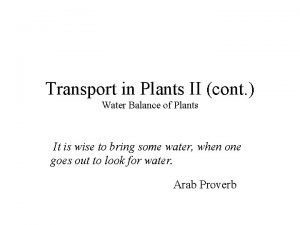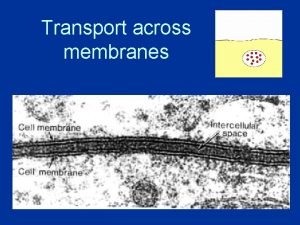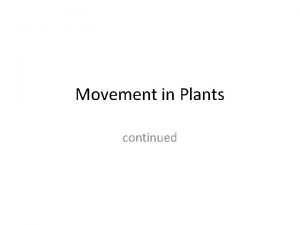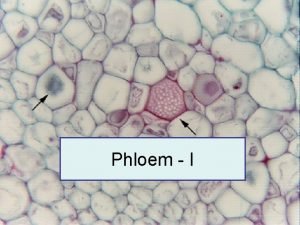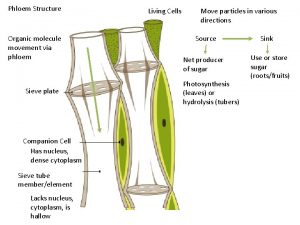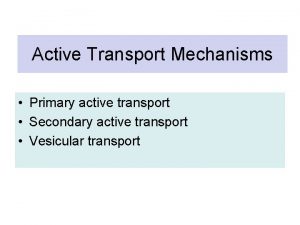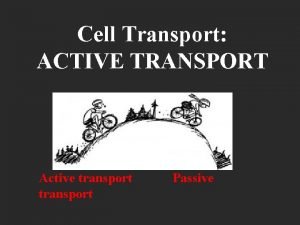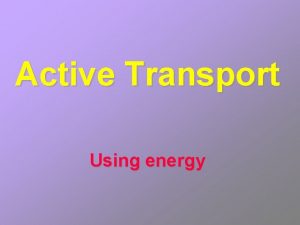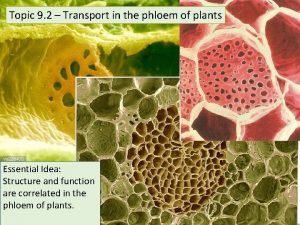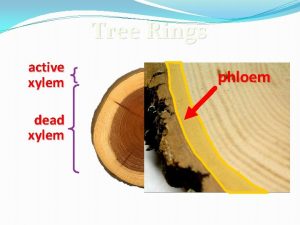Topic 9 2 PHLOEM TRANSPORT Topic Outline Active













- Slides: 13

Topic 9. 2 PHLOEM TRANSPORT

Topic Outline þ Active Translocation þ Phloem Structure þ Companion Cells þ Source Loading þ Mass Flow þ Sink Unloading þ Translocation Rate Structure and function are correlated in the phloem of plants AUDIO

Active Translocation Plants transport organic molecules from sources to sinks • Sources: Photosynthetic tissues (e. g. leaves) • Sinks: Storage organs (e. g. fruits, seeds, roots) Source The organic molecules are transported via a tube system called the phloem, via the process of active translocation • Active loading of solutes into the phloem draws water from the xylem, creating a pressure gradient (mass flow) Plants transport organic compounds from sources to sinks PHLOEM Sink

Phloem Structure Phloem comprise of sieve elements and companion cells • Sieve elements connect to form a tube with porous plates at their transverse ends (allows material flow) • Sieve elements have no nuclei (to maximise space) and have thick and rigid cell walls (to withstand pressure) • Companion cells possess an highly folded membrane so as to maximise SA: Vol ratio (more material exchange) • Plasmodesmata connect the two cells (symplastic flow) Structure-function relationships of phloem sieve tubes Sieve Cell. Companion Cell

Phloem versus Xylem PHLOEM XYLEM Transports organic molecules Transports water and minerals End walls (sieve plates) exist between cells No end walls between cells (continuous tube) Two-way movement (bidirectional) One-way movement (unidirectional) Cells are living but need support (companion cells) Outer cells are not living (xylem vessel is hollow)

Companion Cells Companion cells support phloem transport by: • Providing metabolic support for sieve elements • Facilitate loading and unloading at source and sink COMPANION CELL Companion cells move materials in two ways: • Via interconnecting plasmodesmata (symplastic) PHLOEM • By actively pumping materials from within the cell wall space of the companion cells (apoplastic) Active transport is used to load organic compounds into phloem sieve tubes at the source

Source: Phloem Loading Apoplastic loading is an active process that occurs APOPLAST H+ S against a concentration gradient (and needs ATP) • Protons are pumped out of phloem cells • They passively return via a co-transport protein which facilitates the joint movement of solutes The build up of solutes in the phloem creates a hypertonic solution that draws water via osmosis ATP H+ H+ S PHLOEM Active loading creates high concentrations of solutes in the phloem (hypertonicity) High concentrations of solutes in the phloem at the source lead to water uptake by osmosis

Phloem: Mass Flow High concentrations of solute in the phloem draws water from the xylem (osmosis) • The incompressibility of water causes the sap volume and pressure to increase • High sap pressure at the source causes sap to move to the sink via mass flow Xylem Phloem SOURCE SINK Incompressibility of water allows transport along hydrostatic pressure gradients

Sink: Phloem Unloading Organic molecules are actively unloaded at sinks Metabolism • This lowers solute concentration in the phloem, Solutes + ATP causing water to return to the xylem (osmosis) Metabolites • The drop in sap pressure maintains a pressure gradient relative to the source (allows mass flow) Storage Direction of mass flow can be reversed according to need (e. g. growing regions need nutrients from sinks) Raised hydrostatic pressure causes the contents of the phloem to flow towards sinks ATP

Summary: Phloem Transport Active Translocation: Transpiration of water • Source produces organic nutrients • Loaded to phloem Translocation of sucrose • Water from xylem raises sap pressure • Mass flow (phloem) • Unloaded at sink Companion Cells Source (leaf cell) Sink (root cell)

Translocation Rate Translocation rates can be measured using aphid stylets and radioactive carbon dioxide • Aphids are insects that feed on sap in phloem via a stylet (protruding mouthpiece) • Plants incorporate radioactive CO 2 to form radioactively labeled sugars within the sap • Severing a stylet allows sap to be collected Aphid feeding on sap via stylet Analysis of data from experiments measuring phloem transport using aphid stylets and radioactive CO 2

Measuring Translocation The rate of translocation can be measured according to the time taken for the radioactively labeled sugars to be detected at various points along the phloem Glass chamber containing radioisotope (14 CO 2) Starter colony Colony #1 Colony #2 Colony #3 Distance (cm) 0 20 40 60 Time (minutes) 0 85 170 220 Analysis of data from experiments measuring phloem transport using aphid stylets and radioactive CO 2

Topic Review Can you do the following? • Identify types of sources and sinks • Describe the structure of a phloem • Outline the role of companion cells • Describe apoplastic loading of the phloem • Describe the role of the xylem in mass flow • Explain the process of active translocation • Outline how transpiration rate is measured
 Primary vs secondary active transport
Primary vs secondary active transport Primary active transport vs secondary active transport
Primary active transport vs secondary active transport Now answer the following questions
Now answer the following questions Active transport vs passive transport venn diagram
Active transport vs passive transport venn diagram Unlike passive transport, active transport requires *
Unlike passive transport, active transport requires * Bioflix activity membrane transport active transport
Bioflix activity membrane transport active transport Passive trnasport
Passive trnasport Bioflix activity membrane transport active transport
Bioflix activity membrane transport active transport What does phloem transport
What does phloem transport Quote sandwich examples
Quote sandwich examples Uniport symport antiport
Uniport symport antiport Lesson outline transport and defense answer key
Lesson outline transport and defense answer key Active vs passive transport
Active vs passive transport Does exocytosis require energy
Does exocytosis require energy








